The Scourge of Upside Down Knitting Needles: Or, Why Picture Books with Knitting Are Like Picture Books with Math
Two years ago Chuck Wendig asked Twitter the following question:

So, naturally, I wrote this reply:

In the pantheon of completely, utterly nonsensical things to care about, this is my hill. I have staked it out. I will die on this hill. It is a hill that literally LITERALLY no one wants. Yet here I am. Once more, telling you, friends and family and complete strangers, that it is time for my most ridiculous post of the year. The one that I literally work on from January until this very moment. That’s right. It’s incorrect knitting needle placement day.
You can see my previous entries on this topic here thus far:
Now it’s time to call out the picture books of 2022 that got knitting needle placement right and the ones that got it wrong.
As with every time I do this post, I will state right here and now that I know perfectly well why people draw knitting needles incorrectly in picture books. The fact of the matter is that when the ends of the needles are skyward it just looks cooler. It does! It’s not accurate, sure, but it conveys a sense of knitting without, y’know, having to actually do even the most basic research.
ADVERTISEMENT
ADVERTISEMENT
Yet here we are. The books I present to you today are a mix. Some got it right. Some got it wrong. None of the books that got it wrong are bad books either. They’re lovely titles! Some by my favorite illustrators! And yet, I feel that if you get a detail like knitting right in a book, you are worthy of praise. And if you got the knitting needles wrong you’re in good company. P.D. Eastman, Dr. Seuss, Adam Rex, they ALL got it wrong at some point.
And just to cut some of you off at the pass, yes the ends of knitting needles pointing upward is not entirely unheard of. There are Scottish grannies from 70 years ago that may have done it at some point. But unless you see a Scottish gran gran from 1950 on one of these pages, the point is moot. Let me have my petty little post.
I’ll round out the score at the end and we’ll see how 2022 shook out. In alphabetical order . . .
Apple and Magnolia by Laura Gehl, ill. Patricia Metola

Cute cover. Cute art. But this is a knitting post today, folks. HOW do the needles come out in the end?

Interesting. Okay, so this is a case where I think I have to rate the art as “Knitting Neutral”. Though it looks as though Britta here is not so much knitting as swirling her yarns together, the needles are indeed pointing sideways. We’ll give her the benefit of the doubt since it’s a sort of expressionistic style of illustration more than anything else.
The Astronomer Who Questioned Everything: The Story of Maria Mitchell by Laura Alary, ill. Ellen Rooney
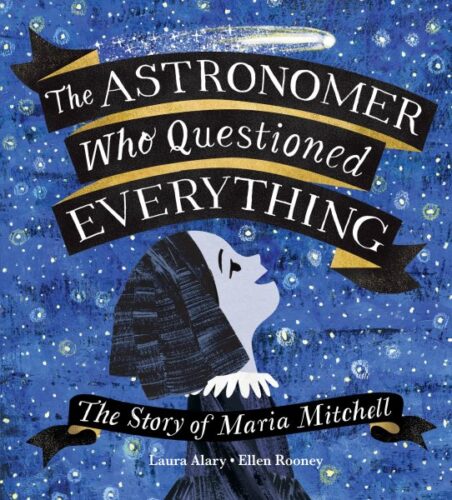
When I said I’d look at knitting in picture books I was counting nonfiction and informational ones as well. Maria Mitchell is, apparently, the hot biographical subject of the moment. She’s already had two, I believe, bios before this one and I just heard about another coming out in 2023. And while I am always delighted when a Quaker gets a biography, how does the knitting hold up in the art?

Okay, so I’m introducing a new category this year. I’m calling it “Not Quite Sure What’s Going On Here Exactly”. It appears that Maria is knitting a mitten. And the needles are indeed facing the correct direction. But help me out here knitters, is it possible to knit a mitten with just two needles like this? Don’t you need rounded needles or four of them? Then again, considering the transparency of the mitten itself, perhaps it’s an art piece more than anything else. So the knitting needle placement is good but the knitting itself? Concerning.
Cloaked in Courage: Uncovering Deborah Sampson, Patriot Soldier by Beth Anderson, ill. Anne Lambelet

I wasn’t kidding about putting nonfiction titles on here! This is the Deborah Sampson story, but don’t worry. You don’t see her knitting in this book. That act is reserved for someone else:
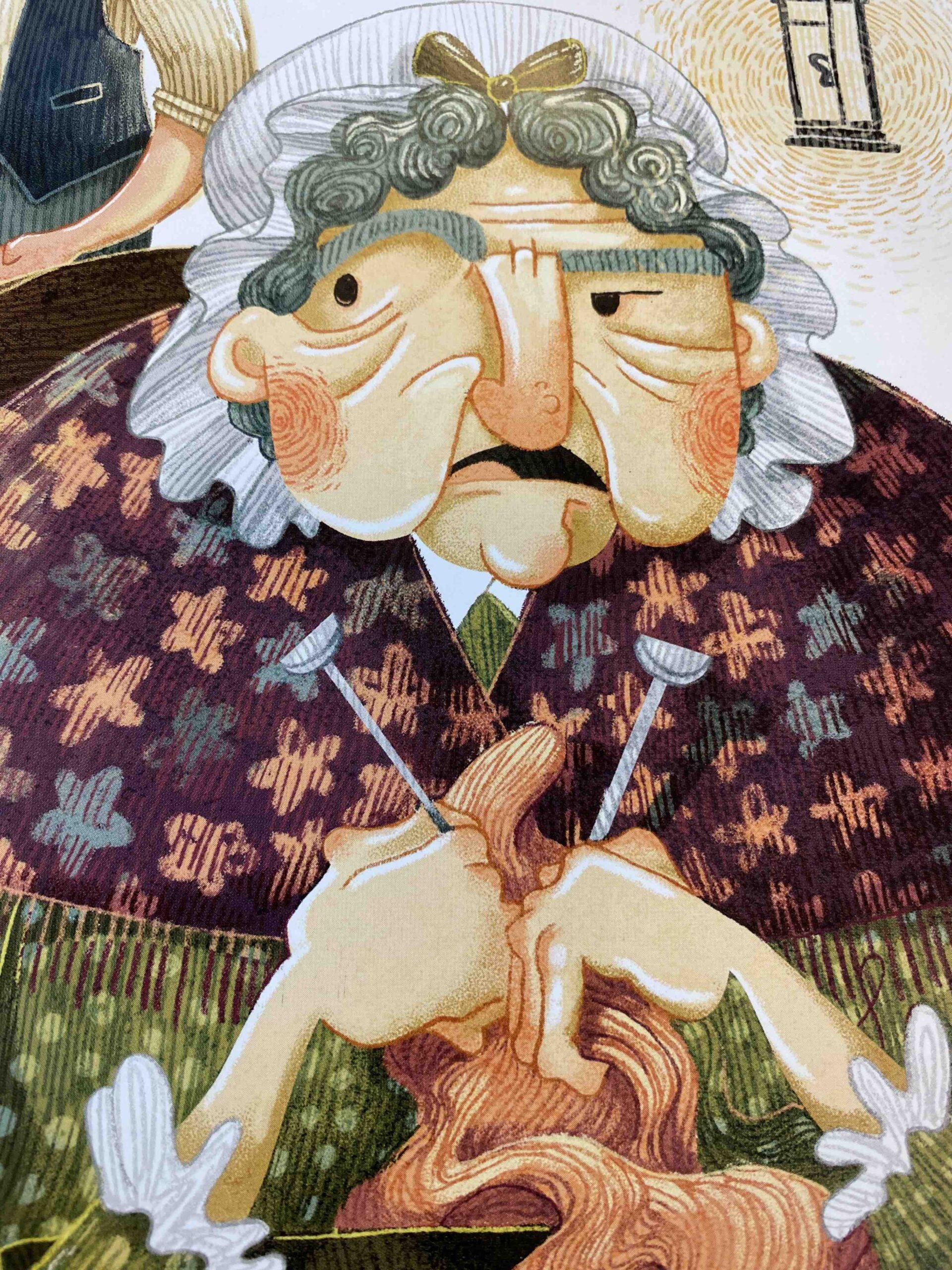
Welp, I’m sorry to say it but I think we have our first inclusion of the day of incorrect knitting needle placement. The thing that’s being knitted is, itself, an interesting shapeless mass, bereft of individual stitches anyway. In the context of the story, I believe this old woman is overhearing Deborah and will later turn out to be her savior, so maybe she’s faking knitting all along and none of the men in the room know to notice that her knitting needles are doing their best possible imitations of TV antennae.
K Is for Kindness by Rina Horiuchi, ill. Risa Horiuchi

Bit of a gear shift. How does knitting fare in a sweeter, younger title?
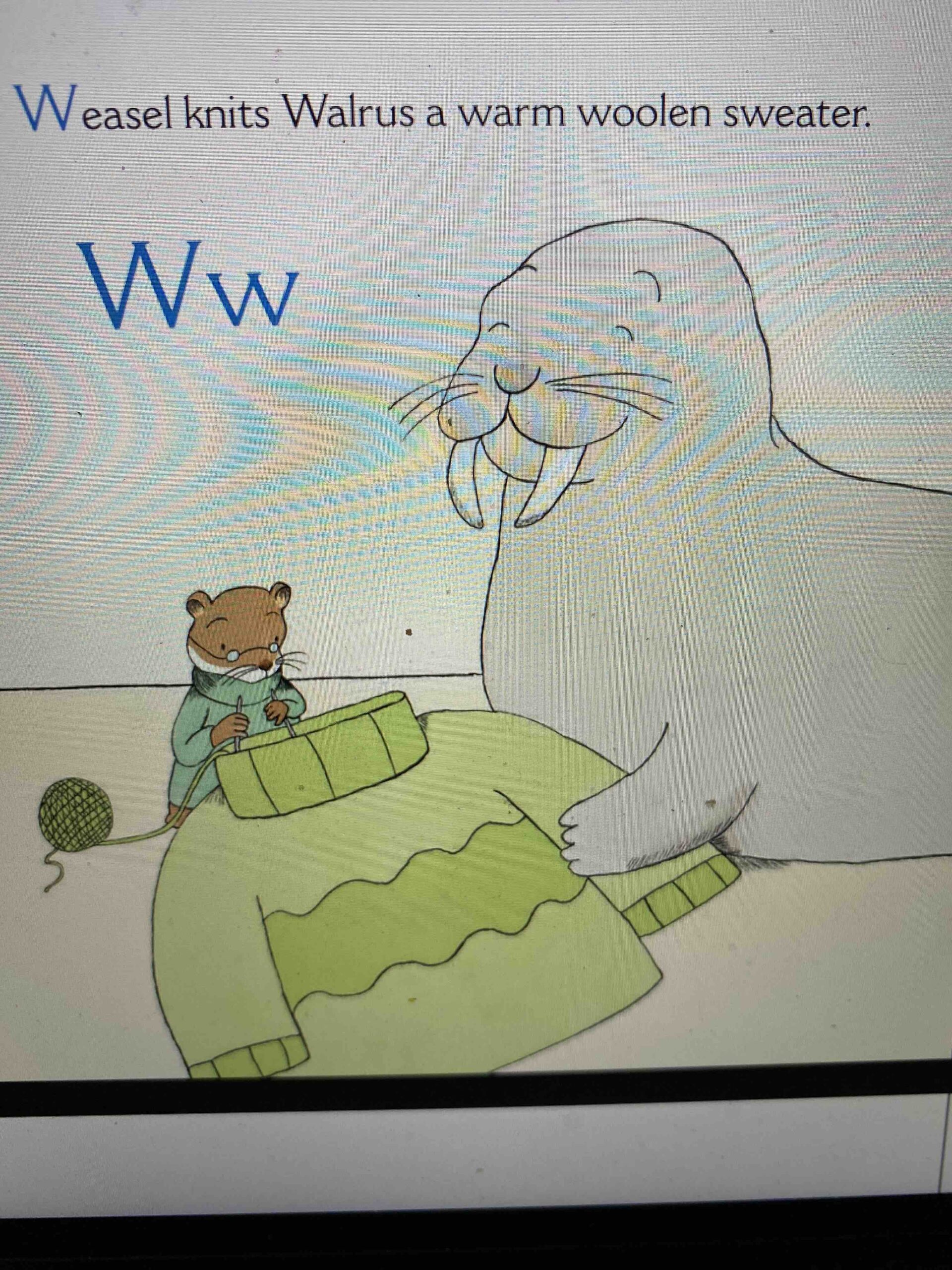
Fascinating! Okay so this little weasel, we are told in the text, has knit this walrus a sweater. And the needle ends are not, I admit, pointing to the sky. Perhaps the weasel is done with the knitting process entirely and is staring at a job well done? But why is that ball of yarn still connected to the neck? Is it attached to one of the needles? Most curious. I’m afraid I’m going to have to place this one into the “Not Quite Sure What’s Going On Here Exactly” category.
Knitting for Dogs by Laurel Molk

As with math, children’s book illustrators can sometimes be a little afraid of their subject matter when knitting is involved. That’s why it’s important to me that the ones that are doing a good job reap the appropriate level of praise. We can already tell by this cover that Laurel Molk probably knows how to knit. Heck, the entire book is about how frustrating it is when you simply are incapable of making the thing that you envision in your head. And just feast your eyes on this variety of knitting, techniques, and even the occasional fixation on how the yarn loops around the fingers!
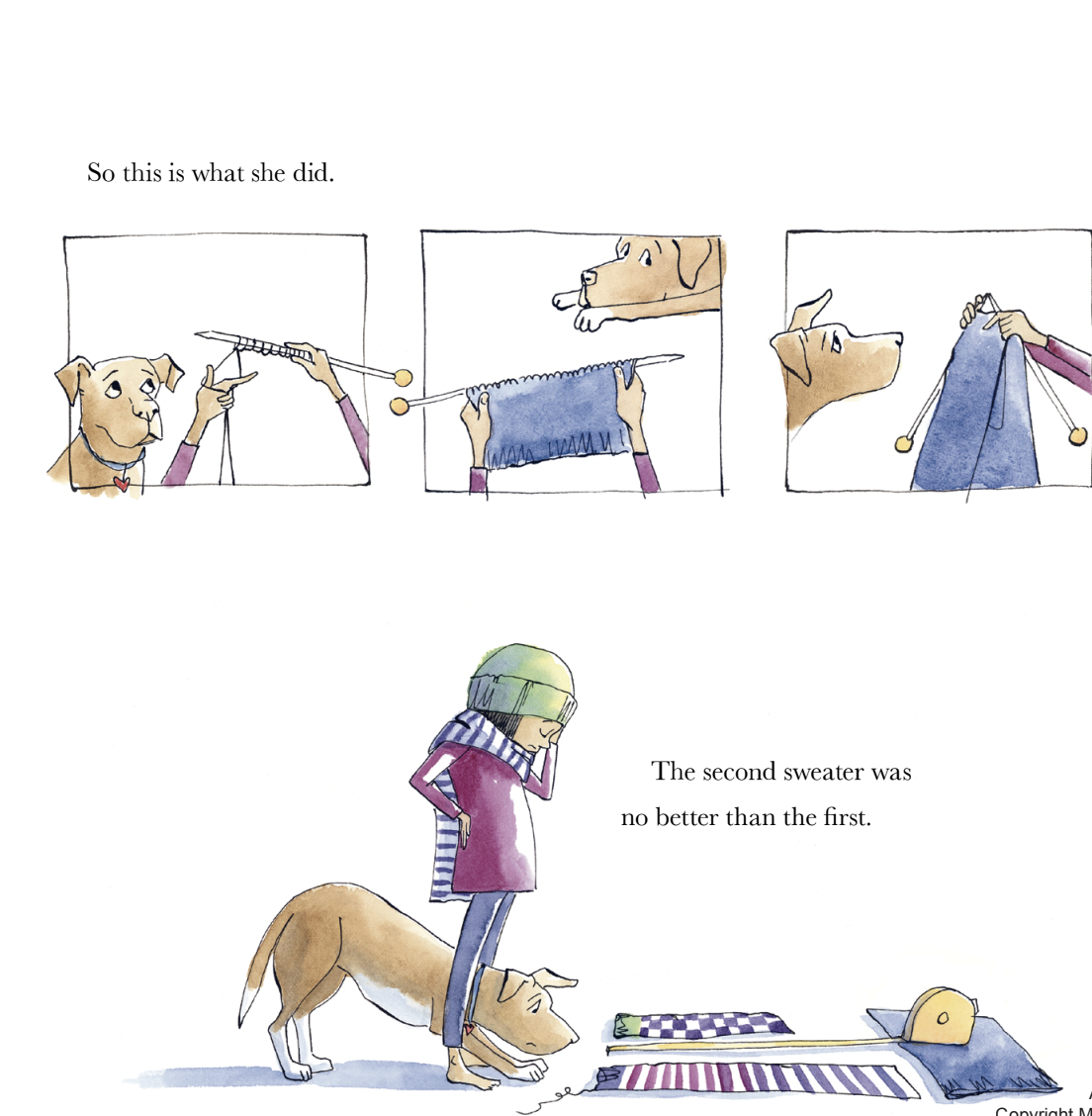

The kicker? She even includes some simplified instructions for getting started on knitting yourself.
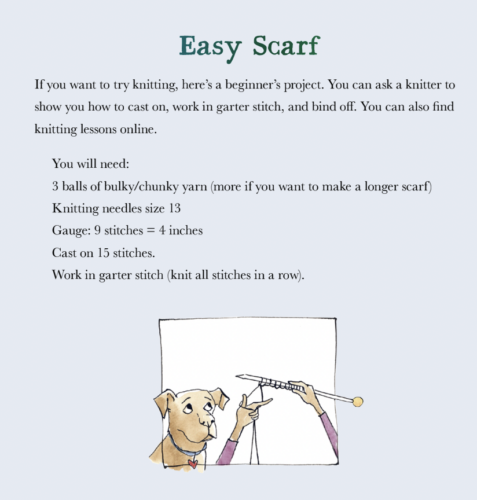
Yeah. There’s no denying it. We have our first out-and-out Excellent Example of proper knitting needle placement and technique.
The Legend of Iron Purl by Tao Nyeu

Don’t ask me how I missed this one on my first go-round of this post. I’m just grateful to Sara Bean Thompson for pointing out that there was an egregious lack on my list. She’s not wrong, and fortunately I was able to confirm that when it comes to superhero knitting stylings, this book knows what it’s doing with needles. Behold!



Monster in the Fog by Ali Bahrampour

You know, folks, a couple years ago I did a post on knitting needles and I mentioned how the mother horse in Robert the Rose Horse, illustrated by P.D. Eastman, just does a crummy job of correctly holding knitting needles. Readers pointed out (not incorrectly) that it can’t be easy to hold needles with hooves. And I’d agree with you, I sure would, except just feast your eyeballs on Hakim’s technique right here!

Earlier this year the author/illustrator was complimented on this scene. Ali Bahrampour then responded, “I paid close attention to that not only because it’s the opening scene but because the book is dedicated to my niece, whose mother, my older sister, is a fantastic knitter, and I knew she was going to notice.” I salute that sister.
My Hands by Nejib

Our first board book! One about the things that hands can do. Including . . .

Nice technique there! Yes, the yarn is sort of wound around the needle randomly, but at least the fingers are touching said yarn. You get the impression that they’ll start casting on right after you turn the page, so I’m going to be generous and give full credit here.
Ozzie and Prince Zebedee by Gela Kalaitzidis
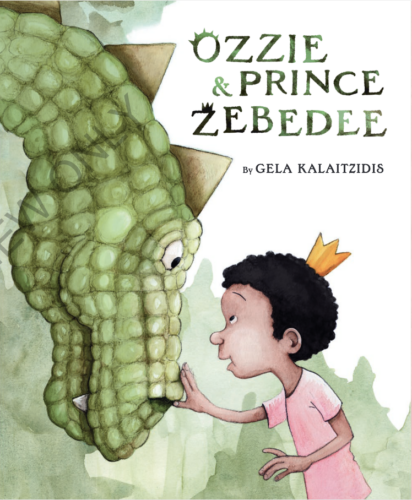
One might not assume that the story of a prince and a dragon would contain copious knitting. One would be wrong and it’s all thanks to this lady right here:
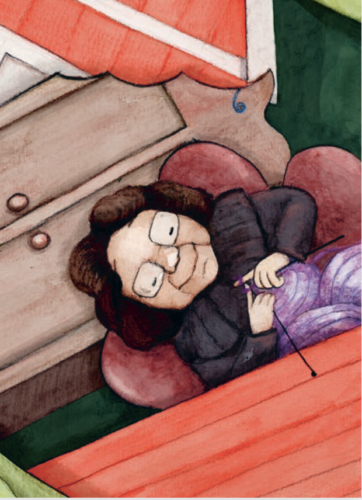
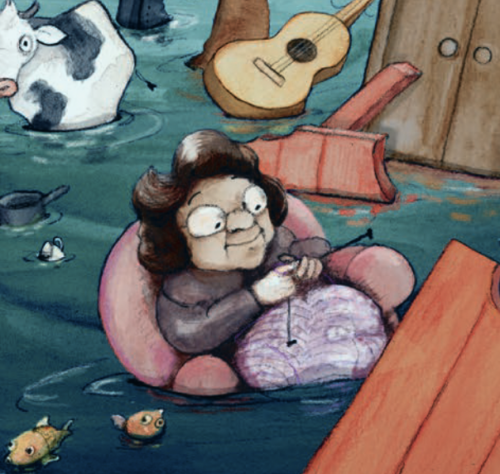
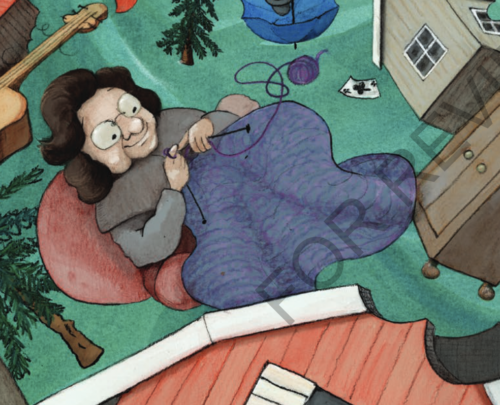
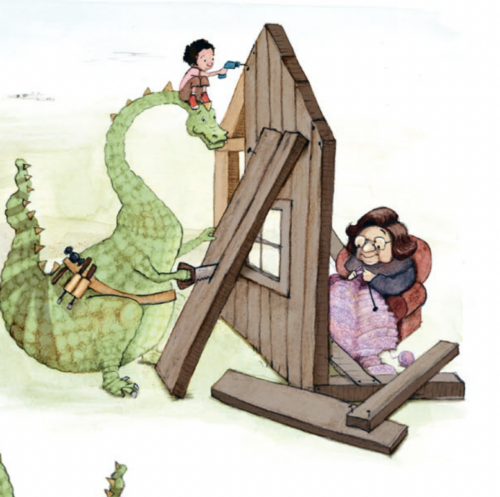
Truth? I could just photograph images of her knitting all day long. I love how the yarn is looped around her pointer finger sometimes. I love the joy she clearly gets from this activity. I just love the whole darn thing. And those knitting needles? Par excellent!
Poppy’s House by Karla Courtney, ill. Madeline Kloepper

We demand gender equity in our picture book knitters and occasionally, once in a while, we get what we want.
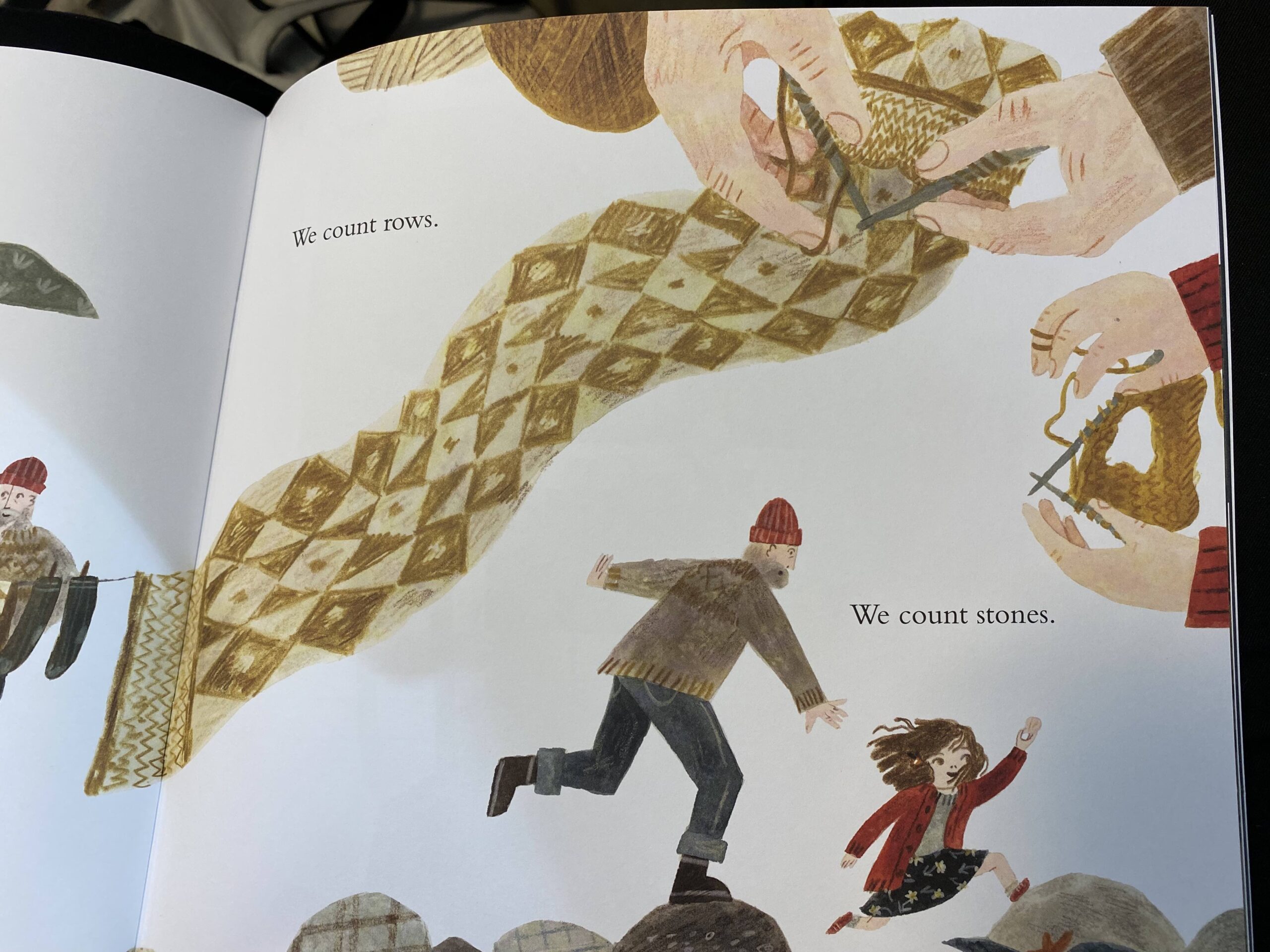
Okay, we may have to give both Karla and Madeline extra points here because there’s a lot going on in this page. There’s the fact that the author knew that counting rows is something you do when you knit. There’s the complexity of Poppy’s knitting vs. the simplicity of the child’s. And you can actually see how the yarn on the knitting needles connects to the knitted object. WELL done!
Skeletina and the In-Between World by Susie Jaramillo
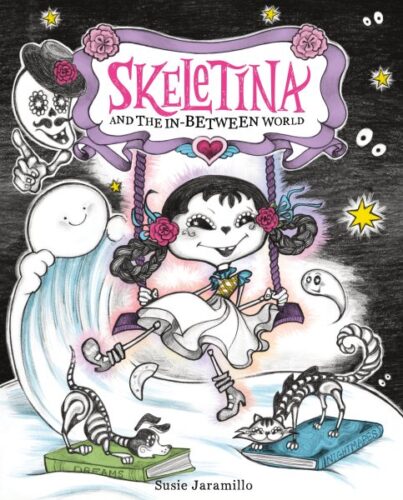
Or, as I like to call it, further proof that just because your world is fantastic, that doesn’t mean your knitting needs to be.
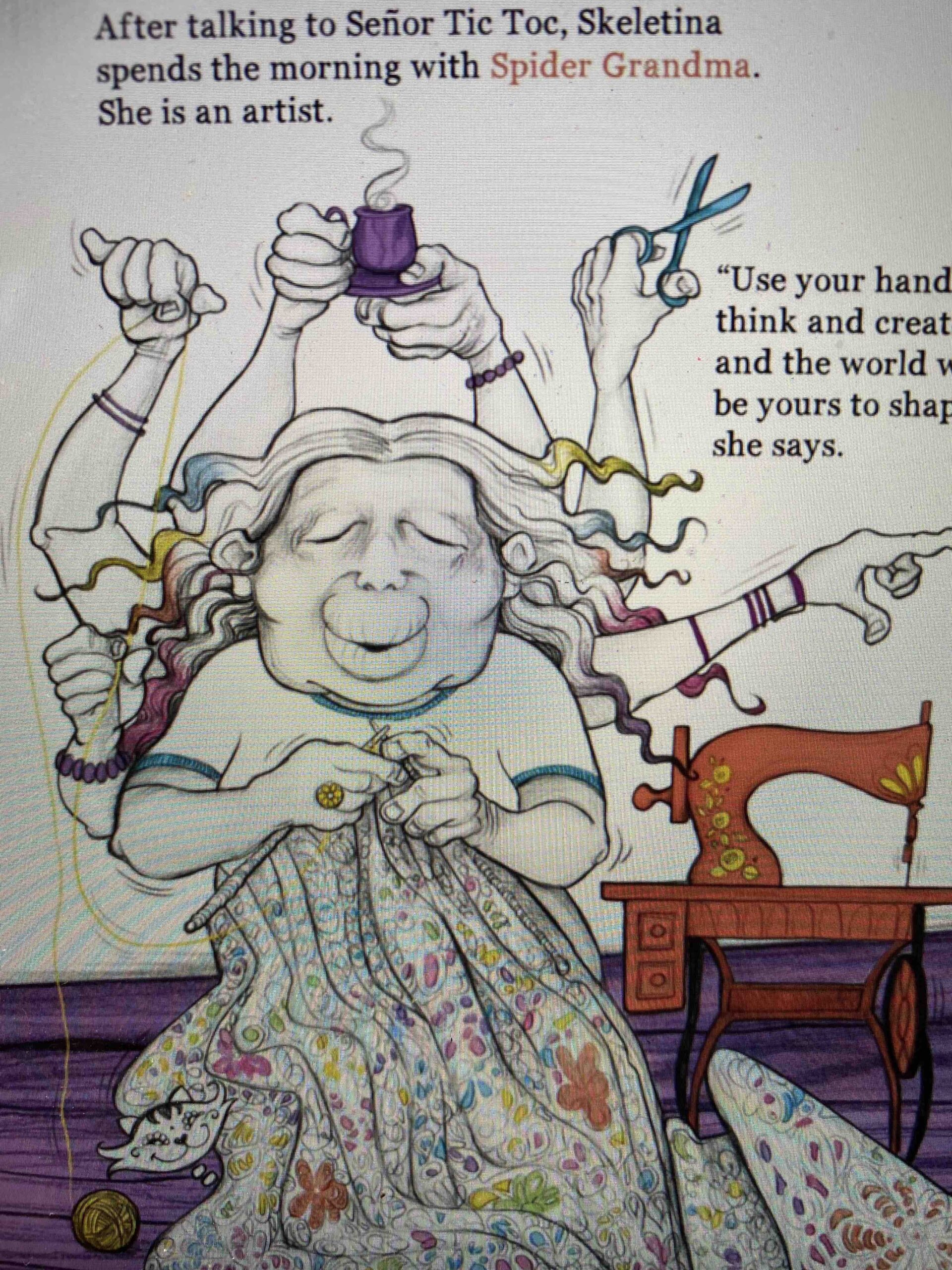
Spider Grandma IS an artist! The knitting needles are dead on, right in the front. I should note as well that this book, if you’re looking for something sweetly creepy, is available in both English and Spanish so check it out!
Sleepy Sheepy by Lucy Ruth Cummins, ill. Pete Oswald

I love me some Lucy Ruth Cummins. I’m a big time fan of Pete Oswald’s general look. But alas, when it comes to knitting, this little sheep just fell asleep on the job.
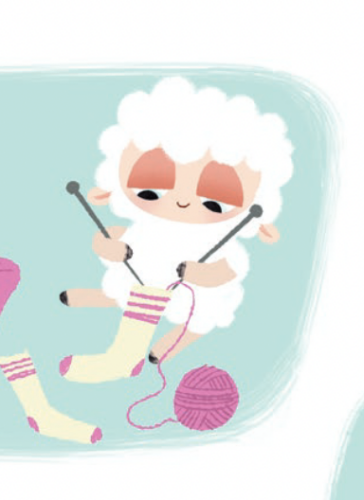
It always looks like someone trying to stab whatever it is they’re “knitting” to death with the needles when they’re held like that. Die, sock, die!!!
We Are Many by Dave Cameron, ill. Suharu Ogawa
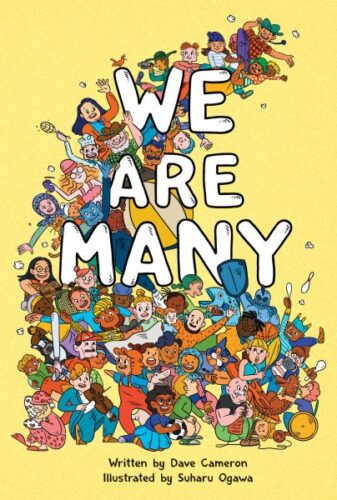
In case you missed this one, this book is a lot of fun. It’s this wild cacophony of chaos and I am HERE for it! Unfortunately, I’m not quite as “here” for the knitter. Like I say, love it when the dudes are knitting, but this feller . . . well, I’m not quite certain what he’s doing:

In this one he appears to be in the process of writing a letter on his scarf-like object . . .

… and here a fully formed sock has appeared out of the ether. You can tell he’s confused by its appearance as well from the way he’s glaring at those knitting needles.
What Feelings Do When No One’s Looking by Tina Oziewicz, ill. Aleksandra Zajac, translated by Jennifer Croll
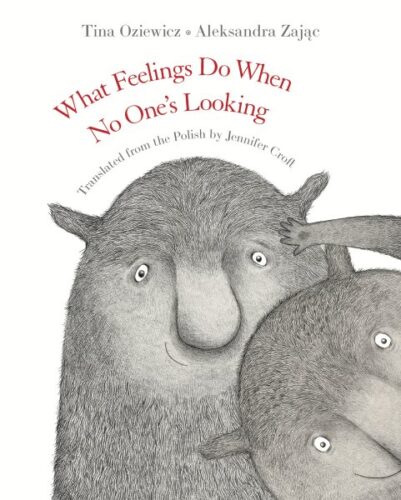
A Polish import for you next! So do Polish illustrators know how knitting works?

Yes indeed! They generally do! Knitting needle ends are distinctly downward facing. Full credit here.
While We Wait by Judy Ann Sadler, ill. Elodie Duhameau

The book that proves that while knitting can do a lot of things, it cannot single-handedly entertain a child for hours on end while they’re waiting for something important. Now check out grandma’s incredible knitting techniques here:
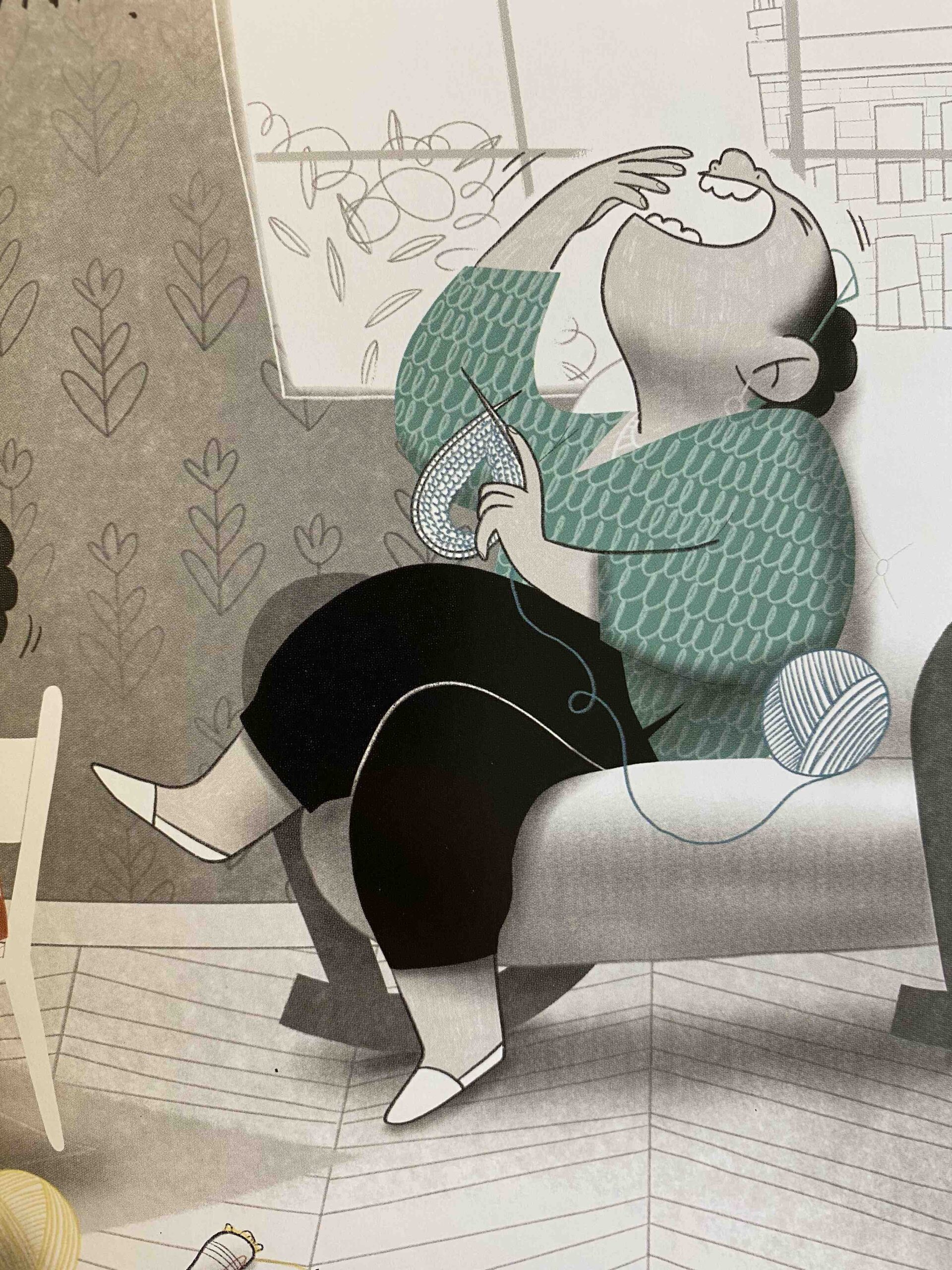
Circular needles! Why are circular needles so rare in children’s books? So far this year I’ve only seen them in this and maybe in the aforementioned Poppy’s House.
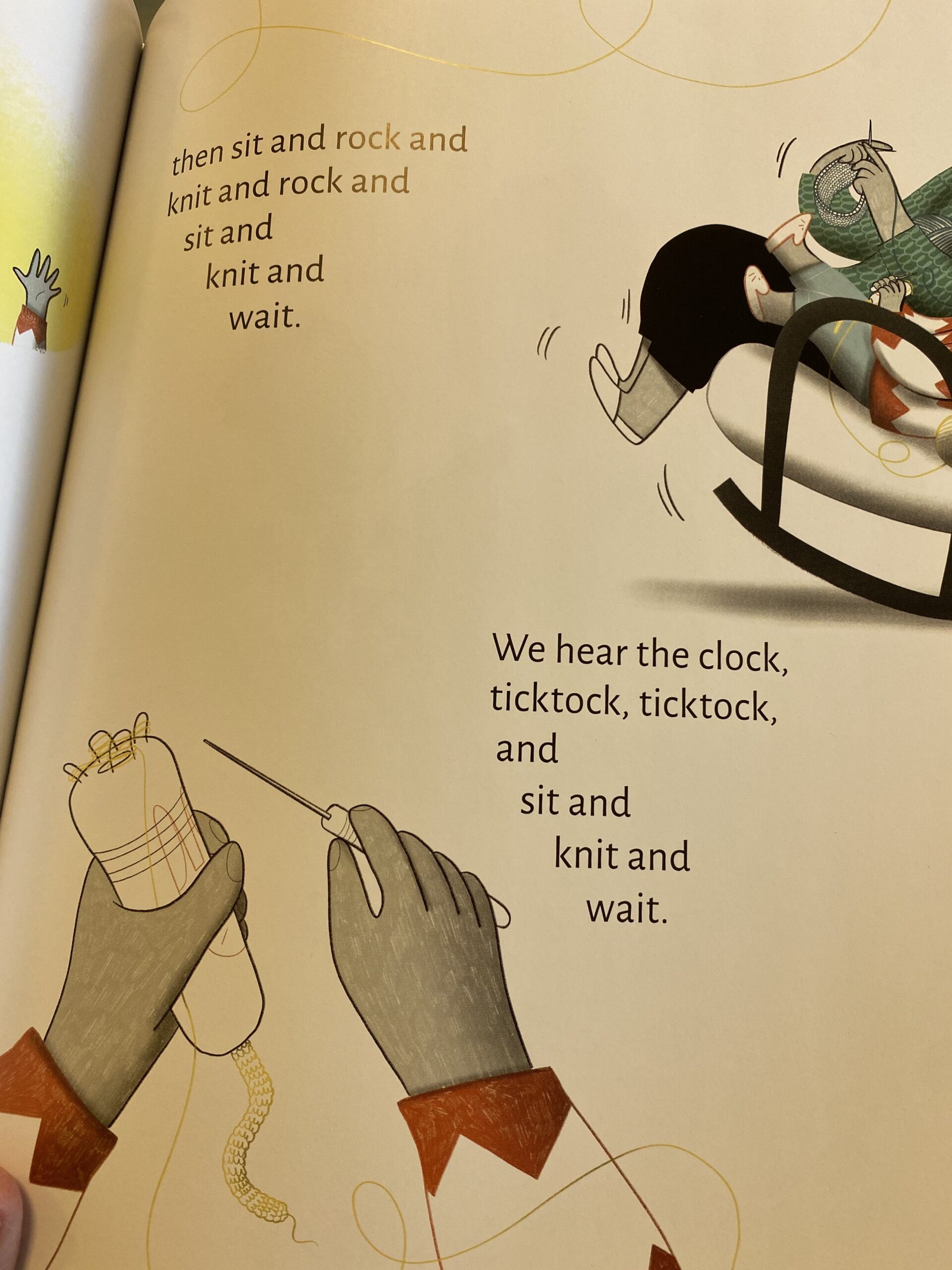
Take a closer look at this. Can you see that the grandson is knitting with his own tool? I should really know its name, but I just don’t. Still, it’s very cool to see it being represented in a book like this.
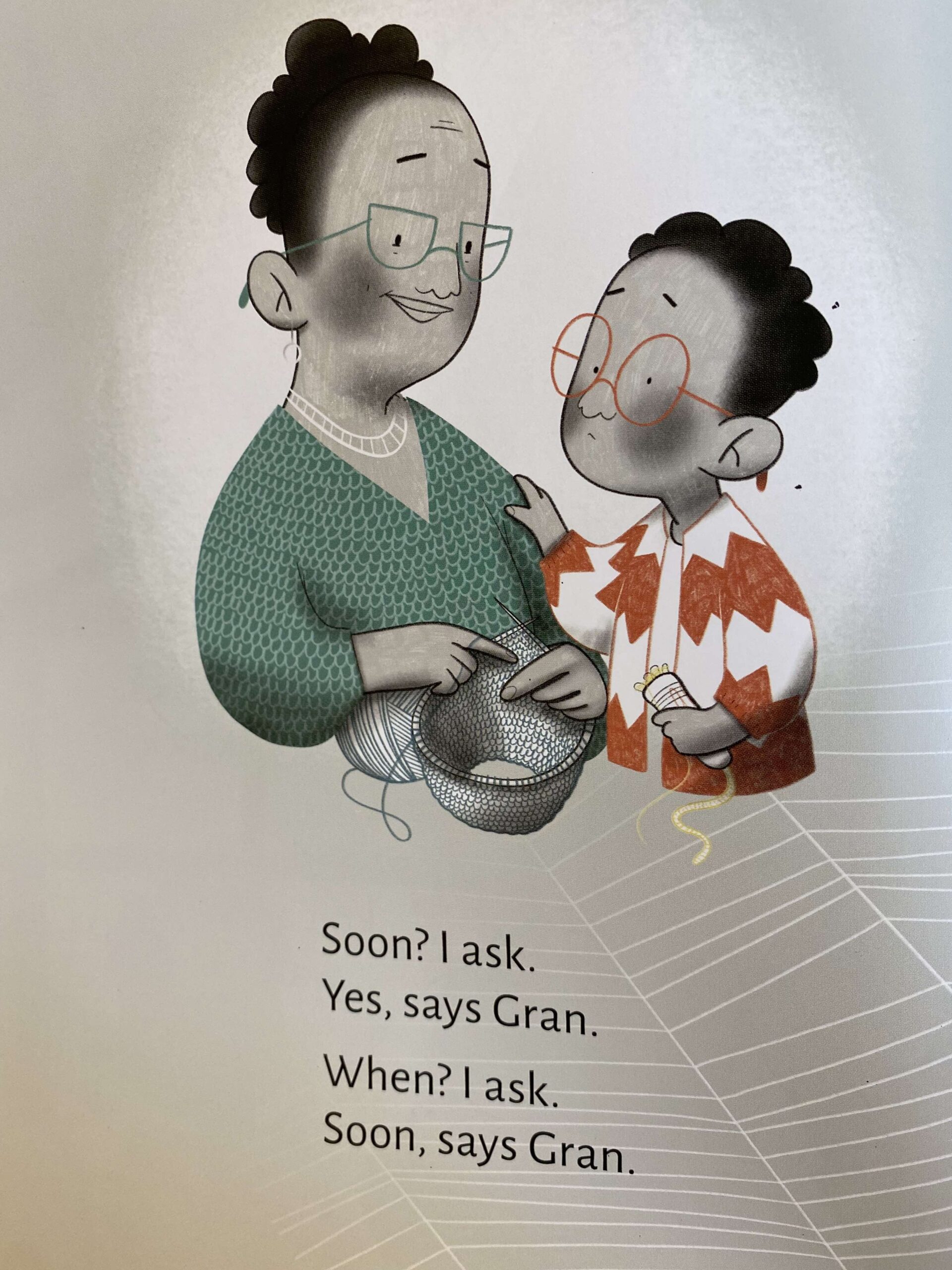
The World’s Longest Sock by Juliann Law

This one’s interesting! There’s a LOT of knitting, in a cross-cultural tale with a man and woman competing for a knitting record. Law also shows that she knows how knitting works right from the cover onward.
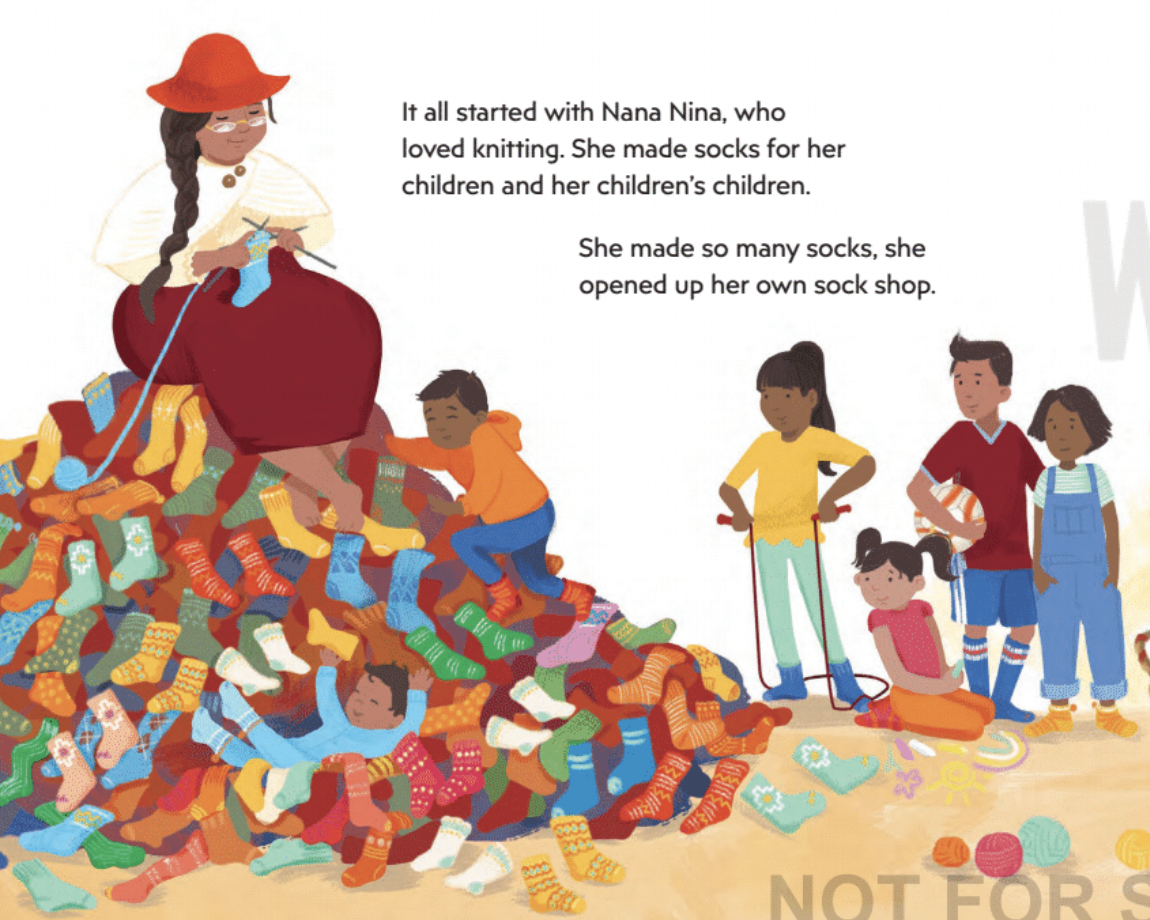
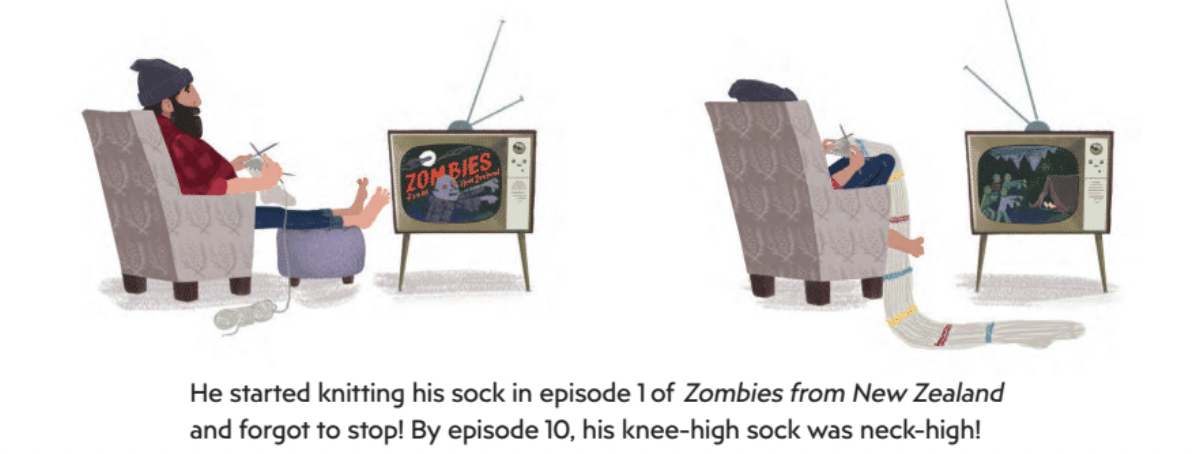

Zoobilations! by Douglas Florian

Seems appropriate to end with Mr. Florian. And the last knitting image is . . .
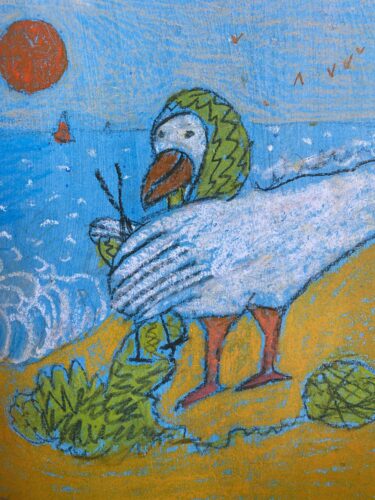
ADVERTISEMENT
ADVERTISEMENT
I’ll give him this: the ends of the knitting needles are pointed downward. However the tips are sky-high and so this slots neatly into the “Not Quite Sure What’s Going On Here Exactly” category for me. You are free to object.
All right, that does it for 2022. Let’s tabulate the results, shall we?
- Excellent Examples of Knitting Where the Illustrators Cared: 9
- Poor Examples of Knitting Needle Placement: 2
- Knitting Neutral: 1
- Not Quite Sure What’s Going On Here Exactly: 4
The moral of the story is that no matter how small a detail is in a book for kids, there will inevitably be some anal retentive adult out there willing to nitpick your knitting.
But wait! There’s more!
Fiber Arts Honorable Mentions
Because it’s not always about the knitting. Sometimes . . . it’s about the spinning.
What Is Math by Rebecca Kai Dotlich, ill. Sachiko Yoshikawa
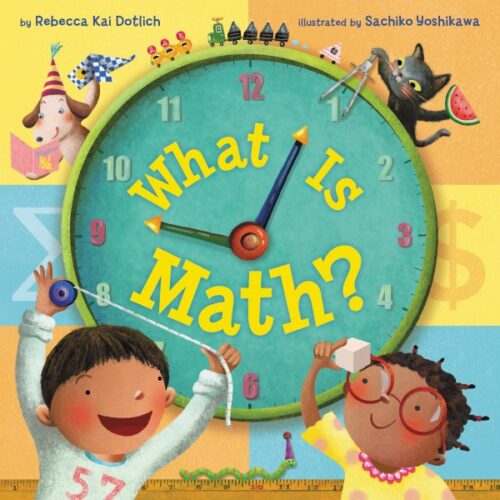
Am I the only one who hears the song “What Is Love?” whenever I read this title? Just me? Okay.
So check out this remarkable array of fiber works that Sachiko Yoshikawa put on the pages just for fun:

My mom used to own (and may still) that object the dog is working with that allows you to wind yarn into a ball. The spinning wheel is also pretty darn accurate. Check out that bobbin! Feast your eyes on the treadle! Somebody did their homework when creating the art for this math book. Color me impressed.
And finally, as is tradition, we conclude with my favorite knitting image of all time. It’s by Amy June Bates of a grumpy squirrel. I have no idea why this continues to amuse me so much. It just does, doggone it.

Filed under: Uncategorized
About Betsy Bird
Betsy Bird is currently the Collection Development Manager of the Evanston Public Library system and a former Materials Specialist for New York Public Library. She has served on Newbery, written for Horn Book, and has done other lovely little things that she'd love to tell you about but that she's sure you'd find more interesting to hear of in person. Her opinions are her own and do not reflect those of EPL, SLJ, or any of the other acronyms you might be able to name. Follow her on Twitter: @fuseeight.
ADVERTISEMENT
ADVERTISEMENT
SLJ Blog Network
Name That LEGO Book Cover! (#53)
Exclusive: Vol. 2 of The Weirn Books Is Coming in October | News
Fighting Public School Book Bans with the Civil Rights Act
Take Five: Middle Grade Anthologies and Short Story Collections
ADVERTISEMENT








I love seeing every installment of this post!
Highly recommend checking out PINK: A Women’s March Story by Virginia Zimmerman and Mary Newell DePalma, too! It’s got very cool mixed-media illustrations that use tiny knit pieces and actual yarn, plus very accurate depictions of knitting. VERY cute.
Betsy, you’ll have to look at The Legend of Iron Purl by Tao Nyeu. I can’t remember the needle placement, but I’m hoping it’s good since the whole book is about knitting superheroes!
https://www.penguinrandomhouse.com/books/313453/the-legend-of-iron-purl-by-tao-nyeu/
Okay, that is an excellent point and now I am downright baffled how I didn’t include this. I certainly read it. Huh. That’s a stumper. Thanks for including it!
Betsy B.
I am relieved to acknowledge that I’m the editor of KNITTING FOR DOGS. Laurel and I are both knitters and it was important to us to get the needles right. Thanks for noticing.
Well, doggone it, someone should.
I’m very honored that I passed the Betsy knitting needle placement approval.
Among all the accolades a book can get this one feels very special and gave me a big smile thank you!
Always one of my favorite posts of the year. 🙂 That tool in While We Wait is called a kniting spool, or Knitting Nancy, or French knitter. It’s for making i-cords.
Ahh! Thank you!
Related question: why is there so much knitting in picture books? What other hobbies or crafts, if any, are featured as much?
I look at every picture book through a knitting shaped lens, so it’s a good question. I suspect quilting may have some representation. Beyond that, not so sure.
Oh, don’t get me started on quilting in children’s picture books! So much to learn there, too!
Love, Love this! I am so sorry I missed the earlier installments before I became a Retired Librarian Grandmother Extraordinaire!!
As a long-time knitter, I feel your pain–and appreciate the posts. A question: Do you think the incorrect positioning of knitting needles is related to the fact that they’re traditionally women’s tools and perhaps not taken seriously? It’s hard to imagine an illustrator showing someone pounding a nail with the claw or grip of a hammer.
That might account for it, except across the board I’d say that all genders are equal participants in incorrect needle placement. But the hammer metaphor is so good that I might steal it for next year. Thank you!!
And all these years I thought I was the only one who noticed the “impossible” knitting! I enjoyed this piece very much. Thank you!
I enjoy every post you’ve made on this and was snort-laughing in the library!
Now off to post this on my Knitting Twitter. <3
Woot woot!
Loved reading your article. FYI: While mittens are often knit with DPNs or circular needles, I have are pattern for straight needles and seamed.
A new book just came across my desk that could be added to this list. “Your Birthday Was the Best!” by Maggie Hutchings and Felicita Sala. I don’t know if all of those legs helps the knitting go faster…but Grandma bug has her own way of knitting! 😛
I chuckled my way through this wonderful article! Thank you! I’m delighted that Élodie Duhameau and I made the well-done knitting list with While We Wait. And I see that Stephanie Best (above) correctly identified the child’s knitting tool. When I was a kid we called it a corker, and I made miles of knitted cord!